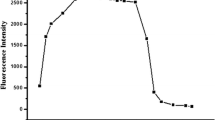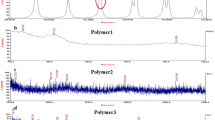Abstract
The ligand 2,6-bis(E)-4-methylbenzylidine)-cyclohexan-1-one sensor has been synthesized as a fluorescence-on sensor/probe for the trace level detection of chromium III ion. The synthesized ligand was characterized by FTIR, 1H-NMR spectroscopy, and fluorimetery. The sensor exhibited an ultra-selective response to chromium among the tested heavy metal ions. Different parameters were optimized like pH, effect of concentration of sensor C, metal ion and contact time. The binding stoichiometry of C:Cr3+ was calculated to be 2:1 (Job’s plot) with a significantly low detection limit of 2.3 × 10− 9 M. Sensor C were practically employed for detection of chromium in spiked water samples.
Graphical Abstract














Similar content being viewed by others
Data Availability
All the data associated with this research has been presented in this paper.
References
Filice FP, Henderson JD, Li MS, Ding Z (2019) Correlating live cell viability with membrane permeability disruption induced by trivalent chromium. ACS Omega 4(1):2142–2151
Bieber VS, Ozcelik E, Cox HJ, Ottley CJ, Ratan JK, Karaman M, Badyal S (2020) Capture and release recyclable dimethylaminomethyl-calixarene functional cloths for point-of-use removal of highly toxic chromium water pollutants. ACS Appl Mater Interfaces 12(46):52136–52145
Vellaichamy B, Periakaruppan P, Nagulan B (2017) Reduction of Cr6+ from wastewater using a novel in situ-synthesized PANI/MnO2/TiO2 nanocomposite: renewable, selective, stable, and synergistic catalysis ACS Sustain. Chem Eng 5(10):9313–9324
Barbosa RF, Souza AG, Maltez HF, Rosa DS (2020) Chromium removal from contaminated wastewaters using biodegradable membranes containing cellulose nanostructures. Chem Eng J 395:125–135
Suo L, Dong X, Gao X, Huang JX, Ye J, Zhao L (2019) Silica-coated magnetic graphene oxide nanocomposite based magnetic solid phase extraction of trace amounts of heavy metals in water samples prior to determination by inductively coupled plasma mass spectrometry. Microchem J 149:104–112
Lei C, Wang C, Chen W, He M, Huang B (2020) Polyaniline magnetic chitosan nanomaterials for highly efficient simultaneous adsorption and in-situ chemical reduction of hexavalent chromium: removal efficacy and mechanisms. Sci Total Environ 733:139–146
Ding J, Pu L, Wang Y, Wu B, Yu A, Zhang G, Gao X (2018) Adsorption and reduction of Cr (VI) together with Cr (III) sequestration by polyaniline confined in pores of polystyrene beads. Environ Sci Technol 52(21):12602–12611
Khan SU, Islam DT, Farooqi IH, Ayub S, Basheer F (2019) Hexavalent chromium removal in an electrocoagulation column reactor: Process optimization using CCD, adsorption kinetics and pH modulated sludge formation. Process Saf Environ Prot 122:118–130
Kim T, Kim TK, Zoh KD (2020) Removal mechanism of heavy metal (Cu, Ni, Zn, and Cr) in the presence of cyanide during electrocoagulation using Fe and Al electrodes. J Water Process Eng 33:101–109
Mahdavi S, Jalali M, Afkhami A (2013) Heavy metals removal from aqueous solutions using TiO2, MgO, and Al2O3 nanoparticles. Chem Eng Commun 200(3):448–470
Kołodyńska D, Bąk JK, Razna JK, Pietrzak R (2017) Uptake of heavy metal ions from aqueous solutions by sorbents obtained from the spent ion exchange resins. Microporous Mesoporous Mater 244:127–136
Fu HR, Xu ZX, Zhang J (2015) water soluble metal-organic frameworks for fast and high dichromate trap** via sinsgle-crystal-single-crystal ion exchange. Chem Mat 27(1):205–210
Ouyang R, Bragg SA (2012) chambers JQ, Xue ZL Flower like self assembly of gold nanopartcles for high sensitive electrochemical detection of chromium (IV). Anal Chim Acta 722:1–7
Tumolo M, Ancona V, Paola DD, Losacco D, Campanale C, Massarelli C, Uricchio VF (2020) Chromium pollution in european water, sources, health risk, and remediation strategies: an overview. Int J Environ Res Public Health 17(15):54–68
Hao J, Li XY, Zhang Y, Dong WK (2018) A reversible bis(salamo)-based fluorescence sensor for selective detection of Cd2+ in water-containing systems and food samples. Mater 11(4):523–530
Acha ND, Elosua C, Corres JM, Arregui FJ (2019) Fluorescent sensors for the detection of heavy metal ions in aqueous media. Sens 19(3):599–604
Chu ZY, Wang WN, Zhang CY, Ruan J, Chen BJ, Xu HM, Qian HS (2019) Monitoring and removal of trace heavy metal ions via fluorescence resonance energy transfer mechanism: In case of silver ions. Chem Eng J 375:121–127
Chen S, Xue Z, Gao N, Yang X, Zang L (2020) Perylenediimide-based fluorescent and colorimetric sensors for environmental detection. Sens 20(3):917–923
Li E, Zeng X, Fan Y (2009) Removal of chromium ion (III) from aqueous solution by manganese oxide and microemulsion modified diatomite. Desalination 238(1–3):158–165
Prohl M, Schubert US, Weigand W, Gottschaldt M (2016) Metal complexes of curcumin and curcumin derivatives for molecular imaging and anticancer therapy. Coord Chem Rev 307:32–41
Carmona-Vargas CC, Alves DC, Brocksom TJ, Oliveira KT (2017) Combining batch and continuous flow setups in the end-to-end synthesis of naturally occurring curcuminoids. React Chem Eng 2(3):366–374
Badal MMR, Ashekul IHM, Maniruzzaman M, Abu Yousuf M (2020) Acidochromic behavior of dibenzylidene cyclohexanone-based bischalcone: experimental and theoretical study. ACS Omega 5(36):22978–22983
Tamang N, Ramamoorthy G, Joshi M, Choudury AR, Kumar S, Golakoti NR, Doble M (2020) Diarylidenecyclopentanone derivatives as potent anti-inflammatory and anticancer agents. Med Chem Res 29(9):1579–1589
Zhang H, Liu Q, Wang T, Yun Z, Li G, Liu J, Jiang G (2013) Facile preparation of glutathione-stabilized gold nanoclusters for selective determination of chromium (III) and chromium (VI) in environmental water samples. Anal Chim Acta 770:140–146
Dutta A, Mahapatra M, Deb M, Mitra M, Dutta S, Chattopadhyay PK, Singha NR (2020) Fluorescent terpolymers using two non-emissive monomers for Cr(III) sensors, removal, and bio-imaging. ACS Biomater Sci Eng 6(3):1397–1407
Saini A, Bhasin AK, Singh N, Kaur N (2016) Development of a Cr(III) ion selective fluorescence probe using organic nanoparticles and its real time applicability. New J Chem 40(1):278–284
Carney MJ, Robertson NJ, Halfen JA, Zakharov LN, Rheingold AL (2004) Octahedral chromium (III) complexes supported by bis (2-pyridylmethyl) amines: ligand influence on coordination geometry and ethylene polymerization activity. Organometallics 23(26):6184–6190
Doistau B, Collet G, Bolomey EA, Sadat-Noorbakhsh V, Besnard C, Piguet C (2018) Heteroleptic ter–bidentate Cr (III) complexes as tunable optical sensitizers. Inorg Chem 57(22):14362–14373
Al Thagfi J, Lavoie GG (2012) Synthesis, characterization, and ethylene polymerization studies of chromium, iron, and cobalt complexes containing 1, 3-Bis (imino)-N-heterocyclic carbene ligands. Organometallics 31(6):2463–2469
Park JE, Kang SK, Woo JO, Son KS (2015) Highly active chromium (III) complexes based on tridentate pyrazolyl pyridyl ligands for ethylene polymerization and oligomerization. Dalton Trans 44(21):9964–9969
Balamurugan G, Velmathi S (2018) Coplanarity driven fluorescence turn-on sensor for chromium (III) and its application for bio-imaging. Photochem Photobiol Sci 17(2):239–244
Feng S, Gao Z, Liu H, Huang J, Li X, Yang Y (2019) Feasibility of detection valence speciation of Cr (III) and Cr (VI) in environmental samples by spectrofluorimetric method with fluorescent carbon quantum dots. Spectrochim Acta A Mol Biomol Spectrosc 212:286–292
Sun Z, Yang M, Ma Y, Li L (2017) Multi-responsive luminescent sensors based on two-dimensional lanthanide–metal organic frameworks for highly selective and sensitive detection of Cr (III) and Cr (VI) ions and benzaldehyde. Cryst Growth Des 17(8):4326–4335
Zheng X, Zhang W, Mu L, Zeng X, Xue S, Tao Z, Yamatob T (2010) A novel rhodamine-based thiacalix [4] arene fluorescent sensor for Fe3+ and Cr3+. J Incl Phenom Macrocycl Chem 68(1):139–146
Esteves CI, Raposo MM, Costa SP (2011) Novel highly emissive non-proteinogenic amino acids: synthesis of 1, 3, 4-thiadiazolyl asparagines and evaluation as fluorimetric chemosensors for biologically relevant transition metal cations. Amino Acids 40(4):1065–1075
Acknowledgements
We thank Department of Chemistry, University of Malakand for providing chemicals and research lab facility for conduction of the present work. We also extend our appreciation to Prof. Dr. Yuta Nishina and Dr. Rizwan Khan (Research Core for Interdisciplinary Sciences, Okayama University, Japan) for their help in characterization of the synthesized compounds.
Funding
There has been no significant financial support for conduction of current research work that could have influenced its outcomes.
Author information
Authors and Affiliations
Contributions
Jehangir Khan Carried out the main experimental work. Maria Sadia Encouraged, supervised the findings of the work and took the lead in writing the manuscript. Syed Wadood Ali Shah Supervised the project, conceived and planned the experiments. Robina Naz Contributed to the interpretation of the results. Faiz Ali Contributed to the final version of the manuscript. All authors provided critical feedback and helped shape the research, analysis and manuscript.
Corresponding author
Ethics declarations
Ethics Declarations
In the current study the procedure adopted is safe both for animals, humans and their environment.
Consent to Participate
All authors have participated in the current research work.
Consent for Publication
All authors have given their consent for publishing of this article in the said journal.
Conflicts of Interest
The authors declare that they have no conflicts of interest.
Additional information
Publisher's Note
Springer Nature remains neutral with regard to jurisdictional claims in published maps and institutional affiliations.
Supplementary Information
Below is the link to the electronic supplementary material.
Rights and permissions
About this article
Cite this article
Khan, J., Sadia, M., Shah, S.W.A. et al. 2,6-bis(E)-4-methylbenzylidine)-cyclohexan-1-one as a Fluorescent-on Sensor for Ultra Selective Detection of Chromium Ion in Aqueous Media. J Fluoresc 31, 1759–1770 (2021). https://doi.org/10.1007/s10895-021-02806-0
Received:
Accepted:
Published:
Issue Date:
DOI: https://doi.org/10.1007/s10895-021-02806-0




